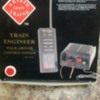Some of you may remember that I picked up a Lionel TMCC Long Island Consol as a display model, tried running it on conventional AC (which it didn't do so well at all), so I gutted it and am now running it on DC. (Nice of Lionel to put DC cans in their newer engines... ![]()
![]()
You also might remember me asking about the smoke unit, and was told that the output might be anemic at best, which it has been....until now.
I have an AristoCraft "Train Engineer Walk-Around Control System". I bought this at one of the (rare) local train shows a few years back. I guess this thing puts full voltage to the track at all times, then feeds the engine via the remote. Kind of a "poor man's DCC":
You hook it up to a power source (in my case an MRC Control Master VI) turn the output on that source up to "full", and then run the train with the hand-held remote. As soon as you begin to feed power to the track, the headlight comes on at full brightness, and then off you go. It has always worked very well with my DC-powered trains, in all scales. So it occurred to me that I might try this with the 2-8-0.
Sure enough, since the smoke resistor is now being hit with (in this case 18 volts) at all times, the smoke output is greatly increased; a lap or two around my test oval and I can see a slight "fog" of smoke hanging over the track. I'm not gonna say it's as much smoke as in some of the videos I've seen, but it is vastly improved.
In my ignorance of electronics, I guess I thought that the smoke resistor would only work properly if running off an AC source, but apparently it doesn't care if it's AC or DC.
As always, I don't know if this is of interest to anyone, but I thought I would share it just the same...
Mark in Oregon






